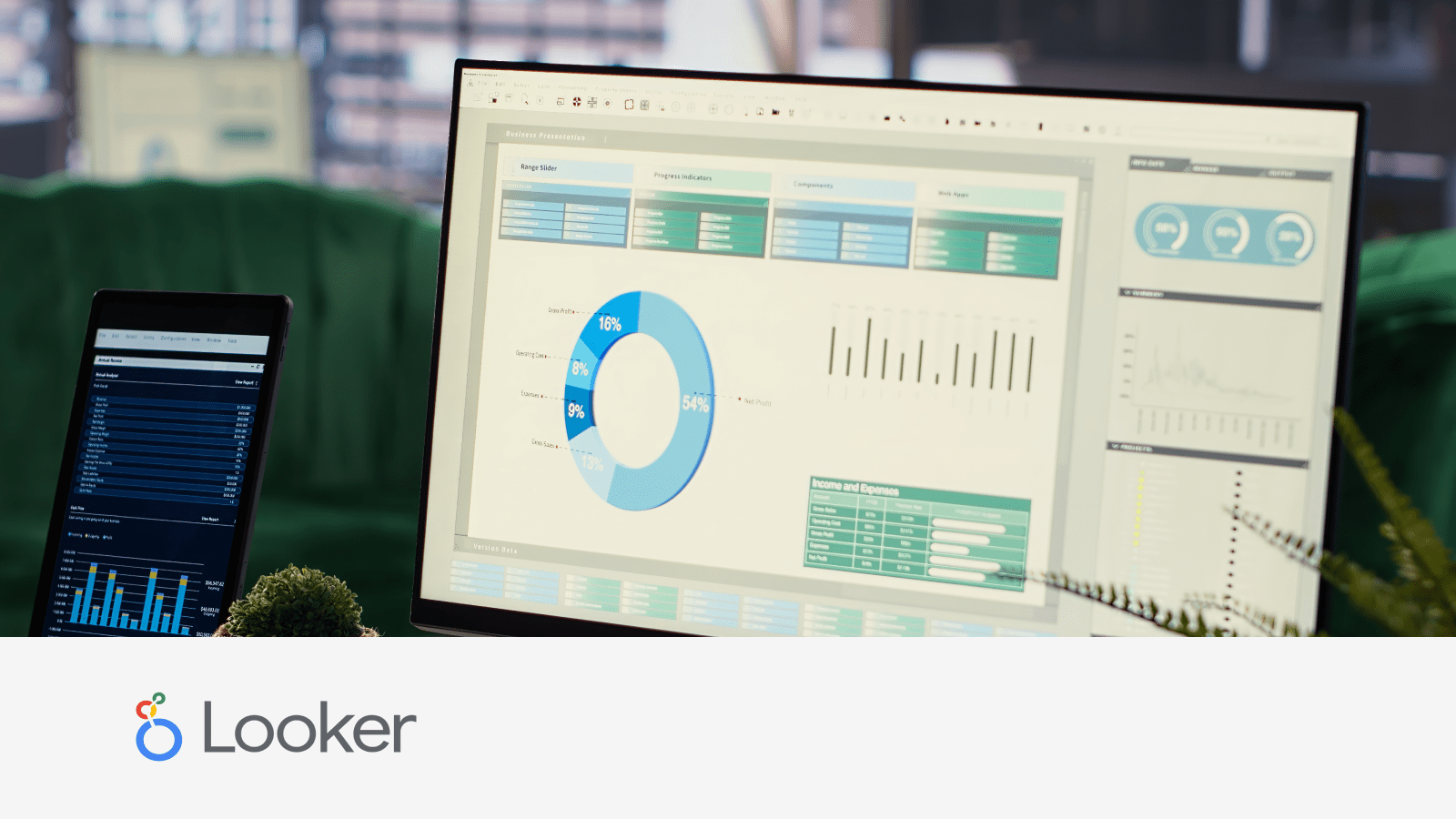Analysing the Bucks' Veteran Core: Data-Driven Insights into NBA Player Longevity and Success
12 Feb 2025

What makes a basketball team successful? Realistically it’s a nuanced question that I can’t possibly answer fully in a blog post, but I can take a stab at it. Good teamwork, coaches, and players come to mind.
I’ve seen success in real time with the Milwaukee Bucks over the last few years. They won the championship in 2021 with a team coached by Mike Budenholzer and led by Giannis Antetokounmpo, Jrue Holiday, and Kris Middleton. The following years saw the coach and Jrue Holiday depart the team for various reasons, and the Bucks haven’t been able to replicate that success. The core of the team is mostly still the same even with those departures. There is however one key difference for the key players remaining, and Jrue Holiday’s replacement, Damian Lillard: age, and it is a major upcoming problem without an injection of some young talent.
Damain Lillard is 34 years old, and the core of the Bucks defense, Brook Lopez, is 36! Giannis is thankfully a bit younger at 30, but as we’ll see most of the rest of these players are around prime retirement age for NBA players. Performance tends to take a slow dip after age 30 for most players. Lebron James of the LA Lakers is a notable anomaly that proves the rule at age 40.
All of the following analysis was done in PowerBI using this dataset.
Note that the data does stop after the 2021-2022 season, but there is plenty of data for all players going back to the 1950s to answer any questions we might have about general basketball stats. The data shows stats for each player each year, including most relevant metrics like points scored and teams played for. I’ve filtered the data used in analysis to the 1980-1981 season and later as this is the 2nd year with 3 point shooting. I assumed there would be some odd data in the first year of 3 point shooting as teams figure out how to use it.
How does age impact output?
Sports are a bit of an odd profession when you think about the age of peak output. If we take salary as a proxy for competence and output, then according to ABS data, salary and output peaks in ordinary jobs peaks between 35 and 55. Basketball players are generally retiring by that point. We also have a whole range of data points we can use as a better measure of success than salary, which is inherently noisy (being a better negotiator generally means a higher salary, but does it mean you are more competent?)
In basketball, we can use metrics like points scored as a better measure of success than salary.
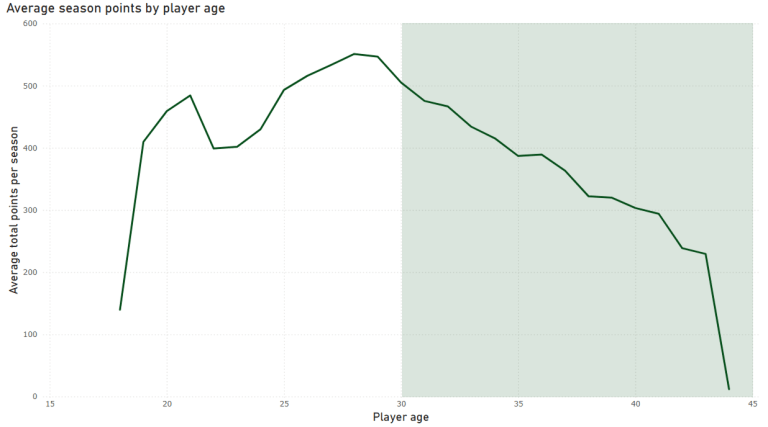
As we can see here the average player scores about 500 points in a season at age 30, and it declines very steadily from there.
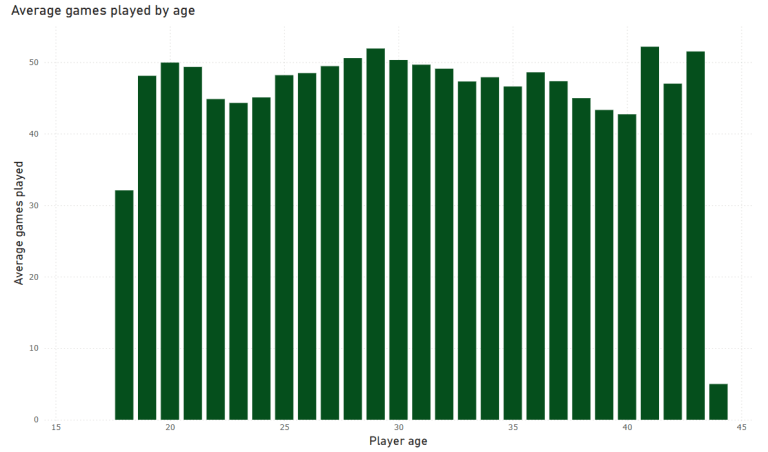
Older players also play in far fewer games per season as they age. Note that the spike from 42-44 is best explained as outliers and survivorship bias, as well as low sample size.
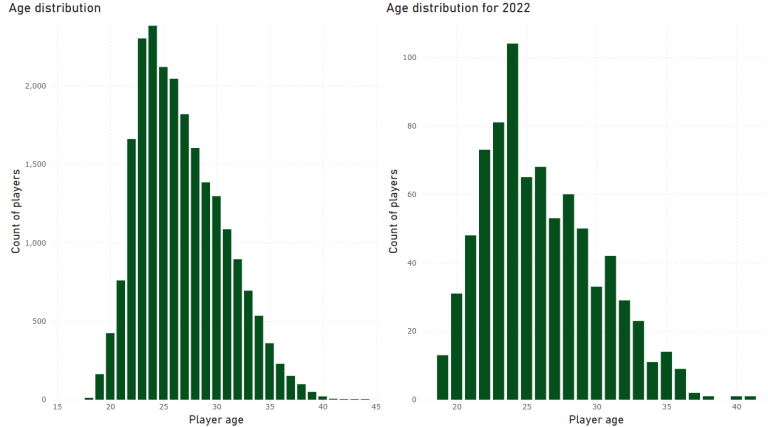
Here is the distribution of player ages for both all players over time, and 2022 specifically. Note how the most common age is 24, and a player making it to age 30 is relatively rare and age 40 almost never happens in both distributions. 4 strong defensive players made it to this age in the league over the course of the league’s history – it’s unlikely any team would keep a 40+ year old on the team if they weren’t consistently contributing every game.
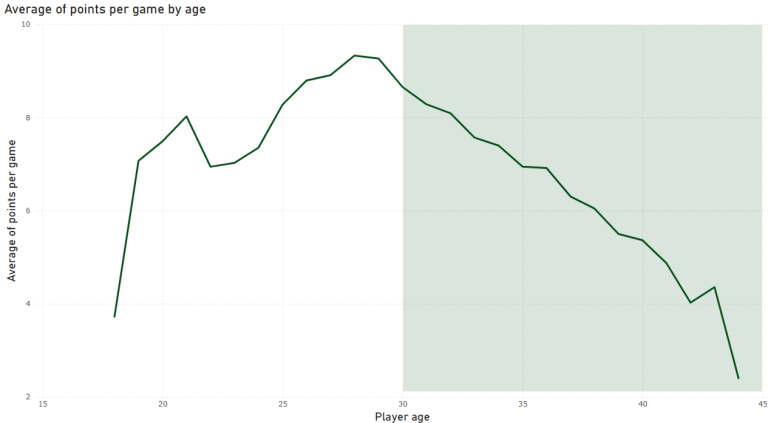
Points per game follows a similar trend, but the drop off is notably less steep. We’ll report on it and other per game metrics where it makes sense going forward as looking at metrics per game played allows us to normalise the data to some extent.
What contributes to player longevity?
Athletic performance across a variety of sports peaks around age 25-29 depending on the sport. Skill based sports have components that don’t deteriorate as quickly as raw power with age. In basketball’s case this means that older players can probably still shoot pretty well, even if they struggle to move as quickly as they could in their youth. In the data this shows up as a greater tendency to shoot 3s as players get older, with a clear trend of 3 pointers making up a rising percentage of points from early years in the league at 22 all the way until age 35.
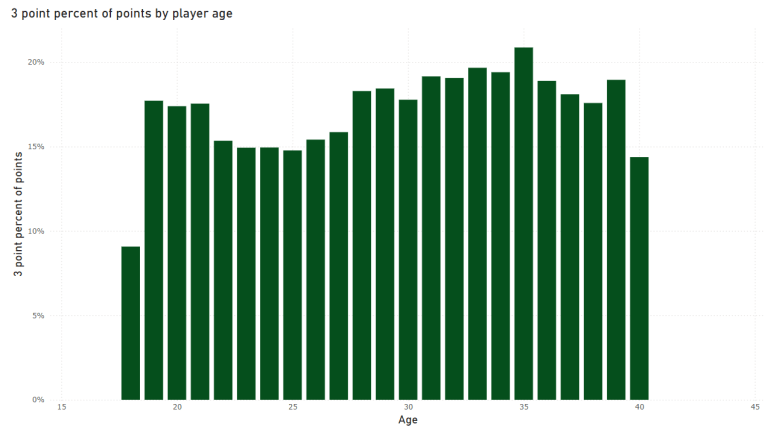
Scoring potential falls as players pass age 30 though, even if the percentage of 3 pointers as a share of points rises. So why do teams keep older players around? Some other stats don’t show this decline at all.
If you look at blocks per game as a very imperfect proxy for defensive ability, there is no visible drop-off as players get older, and if anything the oldest players are the best at blocking, although the small sample size at that age drags the average up.
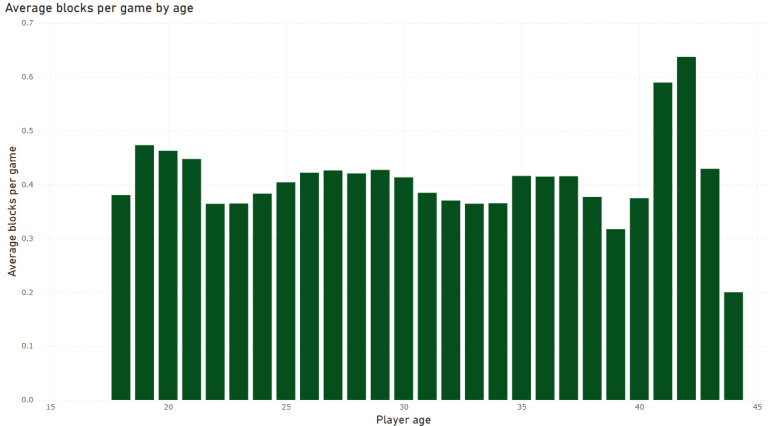
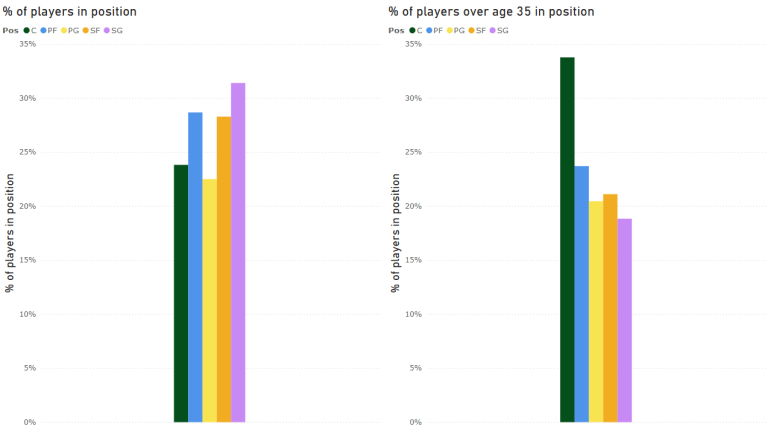
If you look at the positions players play, a very clear trend emerges. Centers (C) are one of the rarest positions for players as a whole. Centers tend to be the tallest and biggest players on any team, and the role they play is defending against shots close to the basket. The pattern flips for players making it past age 35 – with almost about 1/3 of the players being centers at this point. This makes sense, as their size hasn’t changed with age even if their overall athletic ability has diminished. This means they can still do the most important parts of their job.
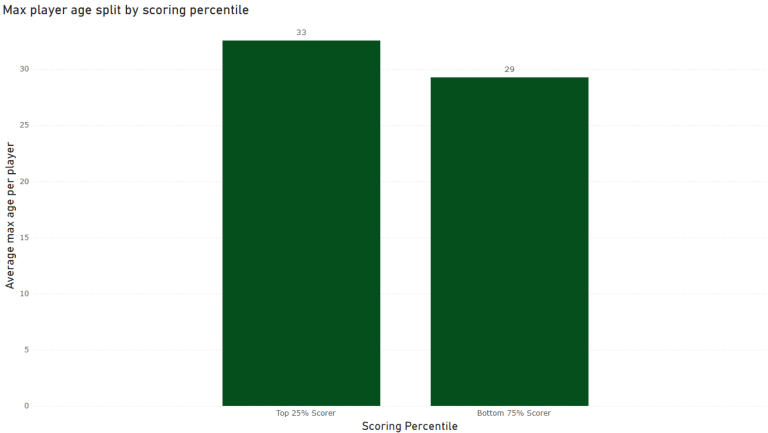
In trying to understand what makes players more likely to play into an older age, I assigned players to percentile groups based on their points per game in the season they were 25 years old. We can see below that being a top 25% scorer gives a player an extra 4 years before retirement at age 33 rather than 29 using maximum player age as a proxy. Note this is correct but biased towards a later age by only looking at players who made it to age 25.
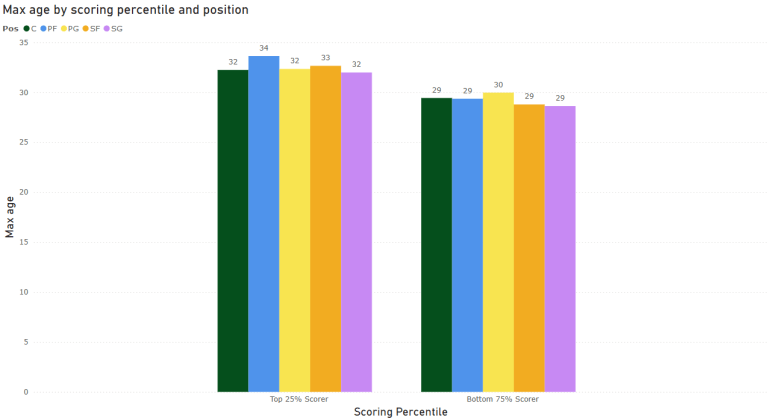
Combining this with a split by position shows us top scoring power forwards retire latest at age 34. Some recent examples of great power forwards retiring late are Tim Duncan, Kevin Garnett, and Dirk Nowitzki, all of whom retired around age 40. Notably, power forwards are typically the largest players on a team after centers, so once again they are able to make use of their size in a slightly older age even if athleticism has diminished. Centers on average retire at 32. It is odd to note that they tend to retire earlier than other top scorer positions even if they tend to be the oldest players on the court, as shown earlier.
Lebron James, the anomaly
Does Lebron James invalidate everything I’ve said above? Afterall, he is still pretty close to the top of his game as a 40 year old power forward. No, he is an outlier and the exception that proves the rule. Let me show you with 2 scatter plots. Note that I only have data up to the 2021-2022 season.
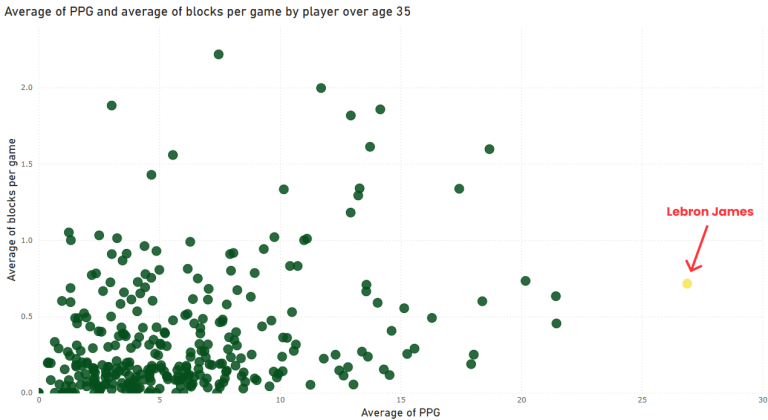
This shows the average points per game and blocks per game for players over age 35 after age 35. The far-right dot? That’s Lebron. The only other players that old scoring more than 20 per game were Michael Jordan, Larry Bird, and Karl Malone; if you’re reading an article about basketball stats I probably don’t need to tell you how those 3 don’t represent normal players. Even so, 20 points per game is good, but considering Michael Jordan had the most dominant season of all time points wise at 37 points per game when he was 23 for example, I wouldn’t call this their peak performance.
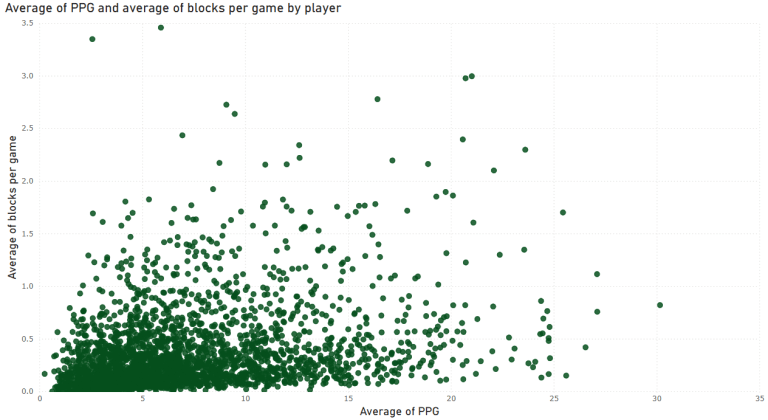
Contrast the over 35 data with the above chart showing the average for all players, and we can see far more players averaging over 20 points per game.
One could make the case that player health and longevity have increased in the last few decades, and Lebron’s long career is a result. The evidence doesn’t exactly support this conclusion at a high level though.

Average player age across the league hasn’t increased over time. If players were really staying healthy for longer, we would expect older players to drag the average up. Average age for top scorers has visibly risen slightly in the last few years, but this might have more to do with contract rule changes than health itself.
Lebron is a great player widely recognised to be one of the best of all time, but he is also setting a historical record every year he plays for points scored per game at his age. Only a handful of players have made it past age 40 in the first place. It’s not impossible he still plays at this level at age 45, but it’s unheard of in the history of basketball.
In Summary
As players age, they tend to perform marginally worse each year past 30 on most metrics. Points per game and games played steadily decline each year. As time goes on, they tend to shoot more 3 point shots. Blocking ability doesn’t appear to change, so good defensive players can contribute at older ages. We see this in players over 35 being centers at a much higher rate than all other positions. The top 25% of scorers tend to retire about 4 years later than the bottom 75% of scorers, at age 33 rather than age 29.
As a Bucks fan (this is the position of the writer, who was born and raised in Wisconsin USA, not EdgeRed Analytics), I found this analysis to be a bit concerning – at least for the current state of the team. Brook Lopez and Damian Lillard are both past the average age of retirement for a good player in their respective positions. Thankfully, Giannis Antetokounmpo probably has a few more good years left as power forward at age 30 but as we’ve shown his performance will likely start to dip in the next few years. This is especially true given his lack of ability to shoot 3 pointers, which becomes particularly important as players age. The Bucks will need to bring up some young talent if they want to continue seeing success in the years to come. But the situation could be worse for the Bucks – at least they aren’t the LA Lakers relying on a 40 year old Lebron James to keep performing at a high level into his mid 40s, which is unheard of in basketball’s history.
Frequestly Asked Questions (FAQs)
How does age impact a basketball player's performance?
Age plays a significant role in basketball performance, with most players peaking in their mid-to-late 20s. After age 30, players tend to experience a gradual decline in key metrics like points scored and games played. Data analytics reveals that shooting three-pointers becomes more common as players age, as it requires less physical exertion compared to driving to the basket.
How can data analytics help predict player longevity in the NBA?
Data analytics can identify patterns in player performance over time, helping to predict career longevity. By analysing metrics like points per game, shooting accuracy, and defense stats, analysts can identify players who are likely to experience longer careers. For example, older centers may continue to contribute effectively on defense even as their athleticism declines, thanks to their size and experience.
How does data analytics track the decline in player performance with age?
Using data analytics, we can track the gradual decline in player performance across several metrics. As players age, their points per game and games played typically decrease, while their reliance on three-pointers increases. By examining historical data on player performance, we can quantify this decline and help teams make informed decisions on player development and roster construction.
What can data tell us about the Milwaukee Bucks' future success?
The performance data of key Milwaukee Bucks players, like Damian Lillard and Giannis Antetokounmpo, shows that age could be a significant factor in their future success. Data suggests that as older players, like Lillard (34) and Brook Lopez (36), enter the twilight of their careers, the team will need to focus on developing younger talent to maintain championship potential in the long term.
This blog was written by Wil Grebner
About EdgeRed
EdgeRed is an Australian boutique consultancy with expert data analytics and AI consultants in Sydney and Melbourne. We help businesses turn data into insights, driving faster and smarter decisions. Our team specialises in the modern data stack, using tools like Snowflake, dbt, Databricks, and Power BI to deliver scalable, seamless solutions. Whether you need augmented resources or full-scale execution, we’re here to support your team and unlock real business value.
Subscribe to our newsletter to receive our latest data analysis and reports directly to your inbox.



